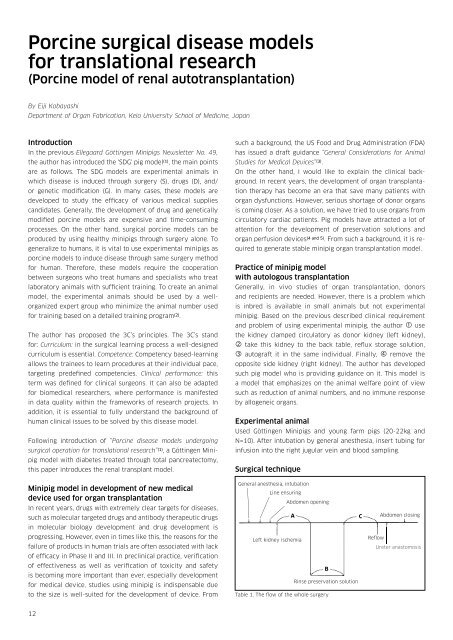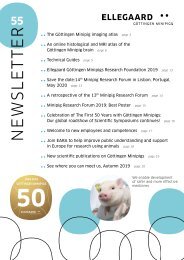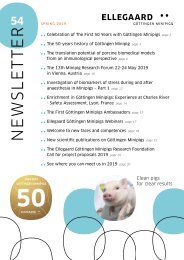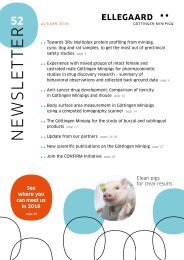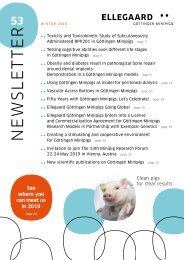Ellegaard_Minipigs_Newsletter_51
You also want an ePaper? Increase the reach of your titles
YUMPU automatically turns print PDFs into web optimized ePapers that Google loves.
Porcine surgical disease models<br />
for translational research<br />
(Porcine model of renal autotransplantation)<br />
By Eiji Kobayashi<br />
Department of Organ Fabrication, Keio University School of Medicine, Japan<br />
Introduction<br />
In the previous <strong>Ellegaard</strong> Göttingen <strong>Minipigs</strong> <strong>Newsletter</strong> No. 49,<br />
the author has introduced the 'SDG' pig model (1) , the main points<br />
are as follows. The SDG models are experimental animals in<br />
which disease is induced through surgery (S), drugs (D), and/<br />
or genetic modification (G). In many cases, these models are<br />
developed to study the efficacy of various medical supplies<br />
candidates. Generally, the development of drug and genetically<br />
modified porcine models are expensive and time-consuming<br />
processes. On the other hand, surgical porcine models can be<br />
produced by using healthy minipigs through surgery alone. To<br />
generalize to humans, it is vital to use experimental minipigs as<br />
porcine models to induce disease through same surgery method<br />
for human. Therefore, these models require the cooperation<br />
between surgeons who treat humans and specialists who treat<br />
laboratory animals with sufficient training. To create an animal<br />
model, the experimental animals should be used by a wellorganized<br />
expert group who minimize the animal number used<br />
for training based on a detailed training program (2) .<br />
The author has proposed the 3C’s principles. The 3C’s stand<br />
for: Curriculum: in the surgical learning process a well-designed<br />
curriculum is essential. Competence: Competency based-learning<br />
allows the trainees to learn procedures at their individual pace,<br />
targeting predefined competencies. Clinical performance: this<br />
term was defined for clinical surgeons. It can also be adapted<br />
for biomedical researchers, where performance is manifested<br />
in data quality within the frameworks of research projects. In<br />
addition, it is essential to fully understand the background of<br />
human clinical issues to be solved by this disease model.<br />
Following introduction of “Porcine disease models undergoing<br />
surgical operation for translational research” (1) , a Göttingen Minipig<br />
model with diabetes treated through total pancreatectomy,<br />
this paper introduces the renal transplant model.<br />
such a background, the US Food and Drug Administration (FDA)<br />
has issued a draft guidance “General Considerations for Animal<br />
Studies for Medical Devices” (3) .<br />
On the other hand, I would like to explain the clinical background.<br />
In recent years, the development of organ transplantation<br />
therapy has become an era that save many patients with<br />
organ dysfunctions. However, serious shortage of donor organs<br />
is coming closer. As a solution, we have tried to use organs from<br />
circulatory cardiac patients. Pig models have attracted a lot of<br />
attention for the development of preservation solutions and<br />
organ perfusion devices (4 and 5) . From such a background, it is required<br />
to generate stable minipig organ transplantation model.<br />
Practice of minipig model<br />
with autologous transplantation<br />
Generally, in vivo studies of organ transplantation, donors<br />
and recipients are needed. However, there is a problem which<br />
is inbred is available in small animals but not experimental<br />
minipig. Based on the previous described clinical requirement<br />
and problem of using experimental minipig, the author use<br />
the kidney clamped circulatory as donor kidney (left kidney),<br />
take this kidney to the back table, reflux storage solution,<br />
autograft it in the same individual. Finally, remove the<br />
opposite side kidney (right kidney). The author has developed<br />
such pig model who is providing guidance on it. This model is<br />
a model that emphasizes on the animal welfare point of view<br />
such as reduction of animal numbers, and no immune response<br />
by allogeneic organs.<br />
Experimental animal<br />
Used Göttingen <strong>Minipigs</strong> and young farm pigs (20-22kg and<br />
N=10). After intubation by general anesthesia, insert tubing for<br />
infusion into the right jugular vein and blood sampling.<br />
Surgical technique<br />
Minipig model in development of new medical<br />
device used for organ transplantation<br />
In recent years, drugs with extremely clear targets for diseases,<br />
such as molecular targeted drugs and antibody therapeutic drugs<br />
in molecular biology development and drug development is<br />
progressing. However, even in times like this, the reasons for the<br />
failure of products in human trials are often associated with lack<br />
of efficacy in Phase II and III. In preclinical practice, verification<br />
of effectiveness as well as verification of toxicity and safety<br />
is becoming more important than ever, especially development<br />
for medical device, studies using minipig is indispensable due<br />
to the size is well-suited for the development of device. From<br />
General anesthesia, intubation<br />
Line ensuring<br />
Abdomen opening<br />
A<br />
C<br />
Left kidney ischemia<br />
B<br />
Rinse preservation solution<br />
Table 1. The flow of the whole surgery<br />
Reflow<br />
Abdomen closing<br />
Ureter anastomosis<br />
12


